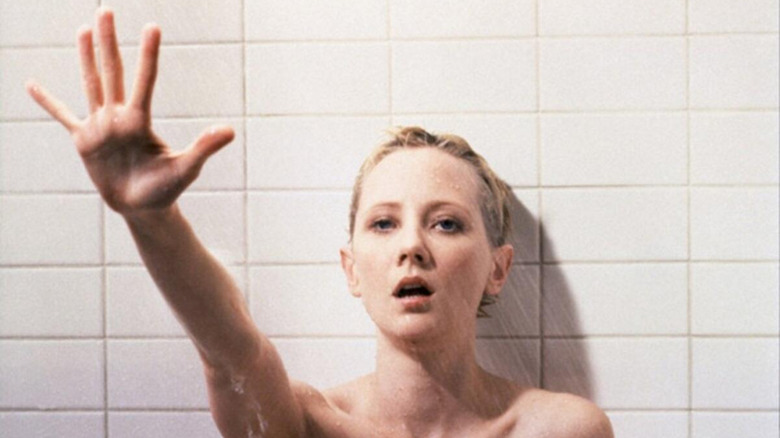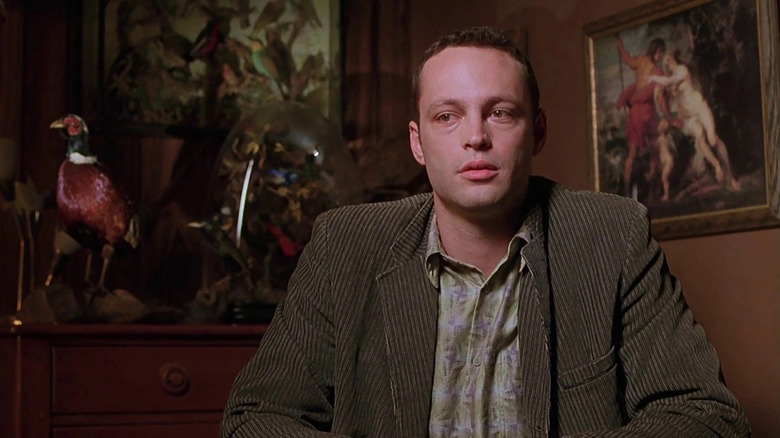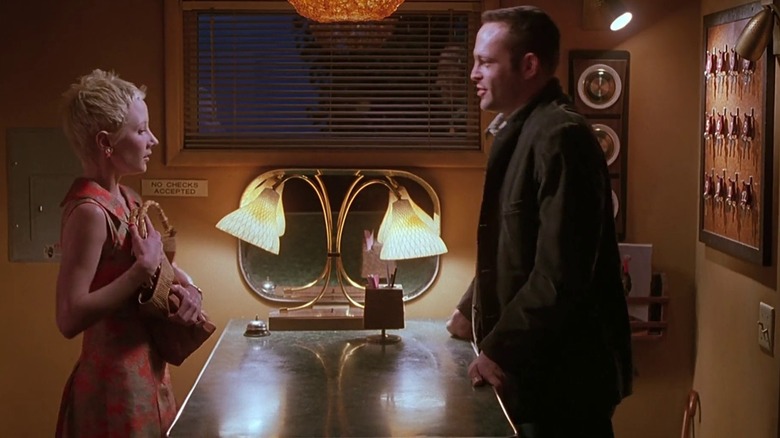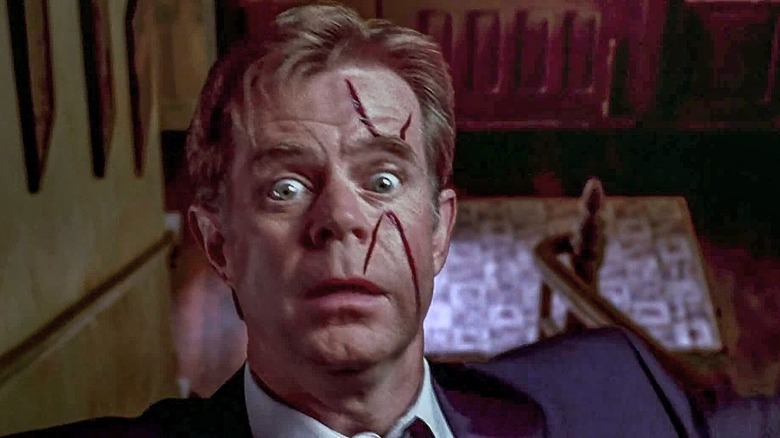The Psycho Remake Is A Bad Movie, But A Massively Successful Experiment
Announced in Deadline on March 23, a remake of Alfred Hitchcock's 1958 film "Vertigo" may very well be in the works. It's likely the cineastes of the world screwed up their faces in disapproval. "Vertigo" might be considered one of cinema's more indelible classics, and it regularly appears near the top — or at the top — of lists of the best movies of all time. Indeed, back in 2012, it surpassed "Citizen Kane" as the #1 film on the famed Sight & Sound poll. It has since been supplanted by Chantal Akerman's 1975 film "Jeanne Dielman, 23 quai du Commerce 1080 Bruxelles."
Briefly: "Vertigo" is a psychodrama about a police investigator named Scottie (James Stewart) who is hired by an old friend to follow his wife Madeline (Kim Novak). Madeline has been behaving strangely, and she seems to be convinced that she is possessed (?) by a dead woman she saw in a portrait. Scottie ends up saving Madeline from a jump into San Francisco Bay, and the two fall intensely in love. Halfway through the movie, the narrative shifts, and Madeline is written out (being spoiler sensitive, I shall not reveal how). Scottie soon begins to obsess over a second woman named Judy (also Novak) whom he tries to remake in his own image.
"Vertigo" is notable for its uniqueness rather than for its universality. Hitchcock's style is what carries a film like "Vertigo," and not its script. Remaking it instantly sounds unwise.
Indeed, remaking a unique Hitchcock classic has been tried unsuccessfully before. In 1998, director Gus Van Sant remade "Psycho" as a shot-for-shot film experiment. It was a misguided enterprise. As a film, "Psycho" clearly failed, but as an experiment in cinematic aesthetics, it proved many interesting things about the medium's evolution.
Why remake 'Psycho?'
No one is quite sure why Van Sant wanted to remake "Psycho" other than to prove that he could. Van Sant hired a new cast of actors, and was to shoot in color, but wanted to adhere to Hitchcock's original storyboards, camera angles, and editing. This new "Psycho" was experimental Kabuki theater, and was meant to precisely recapture the mannerisms and tone of the 1960 film. For the most part, Van Sant was faithful, recreating every shot as best he could, only occasionally adding flourishes of his own. Because it was made in 1998, Van Sant felt permitted to include some nudity, and Viggo Mortensen, as Sam Loomis, mooned the camera. For the murder scenes, Van Sant also included quick-edit flashes to various surreal images, giving his "Psycho" a palpable MTV feeling.
Some changes, however, Van Sant refused to make, even if they would have been practical. In the original film, Marion Crane (Janet Leigh), stole $40,000 in cash before attempting to skip town. To hide the money, Marion divvied up the $40,000 into two stacks and folded them into a newspaper. Because Van Sant's film was set in the modern day, $40,000 didn't seem like enough to steal, so the director upped the amount to $400,000. In order to keep the "two stacks of money" shots in the film, however, Marion had to be seen handling $1,000 bills. Those bills are so uncommon, it looked weird and very noticeable on screen, way more than the $100s of the original. Certainly not the effect Hitchcock was going for in 1960.
As for the cast, they were all effective following their forebears. "Psycho" didn't fail because of Vince Vaughn's performance as Norman Bates, nor Anne Heche's as Marion.
What the experiment proved
Van Sant's movie was met with morbid fascination. Many saw it back in 1998, wondering what on Earth a shot-for-shot remake of "Psycho" might look like. Some critics were impressed by the temerity of the project and its clear status as a mere exercise. Others pointed out that Van Sant did nothing to improve on Hitchcock, and wondered why he would even think to try. Either way, it was a more interesting film to discuss than to watch. As of this writing, Van Sant's film has a 40% approval rating on Rotten Tomatoes.
Even if it failed as a film, however, "Psycho" has a great deal of value as an experiment. In remaking a known classic exactly as it had been done before, Van Sant proved several things.
1. Film style evolves, and adhering to an older, once-effective shooting and editing ethos will not function after a few decades. This may prove why some filmmakers seem to "slow down" late in their careers. It's not that they lost their ability to direct, necessarily. It's that new trends came to supplant and surpass what they had become known for. "Psycho" proved that aesthetics are not permanent, and even indelible classics are mutable and trendy.
2. Every film is the result of its own era, and attempting to elicit shocks from the exact same movie years later will only elicit titters. There was a time when footage of a flushing toilet in "Psycho" caused a minor scandal in Hollywood. By 1998, years after extreme gore movies like "Cannibal Holocaust," Hitchcock's original film was downright tame. There was no way to retain the same kind of impact as Hitchcock's movie because, well, it wasn't 1960 anymore.
Director over storyboard
3. Hitchcock's theory that a storyboard is a more important factor in filmmaking than a director was proven incorrect. In various interviews, Hitchcock said that storyboarding a film is far more interesting than actually shooting it, as that was when he could envision exactly the film he wanted to make. Shooting was, after that, a mere formality. Extrapolating on Hitchcock's words, it seems that an on-set director isn't as vital as having a good photographer and a good editor.
As Van Sant proved, "Psycho" required a director's input more than Hitchcock wanted to admit.
Weirdly, if Van Sant's "Psycho" proved to be just as striking and chilling as the 1960 film, it would have been the less interesting result. Van Sant would have merely proven that great films all possess the same quality and that adhering to authorized, now-sanctioned techniques will produce the exact same results. But the film wasn't fun to watch, and never was able to become appealing beyond its own experimental status. Indeed, Van Sant's "Psycho" feels stodgy and weird when compared to contemporary thrillers. 1998 was the same year as "The X-Files," "Following," and "Disturbing Behavior."
Because the experiment failed, audiences and critics perhaps learned a little more about the necessary maturation of the cinematic medium. Whether we liked it or not, 1998 America had outgrown "Psycho." Hitchcock's film was still enjoyable to modern audiences because it was understood explicitly to be a work of the past. The 1960 version of "Psycho" is still a great film, and teenage horror nuts are still discovering it to this day. But Van Sant also pointed out that context is just as important to enjoying a film as the film itself.
Every film has pretense, and a politic of its time. Van Sant proved it.



